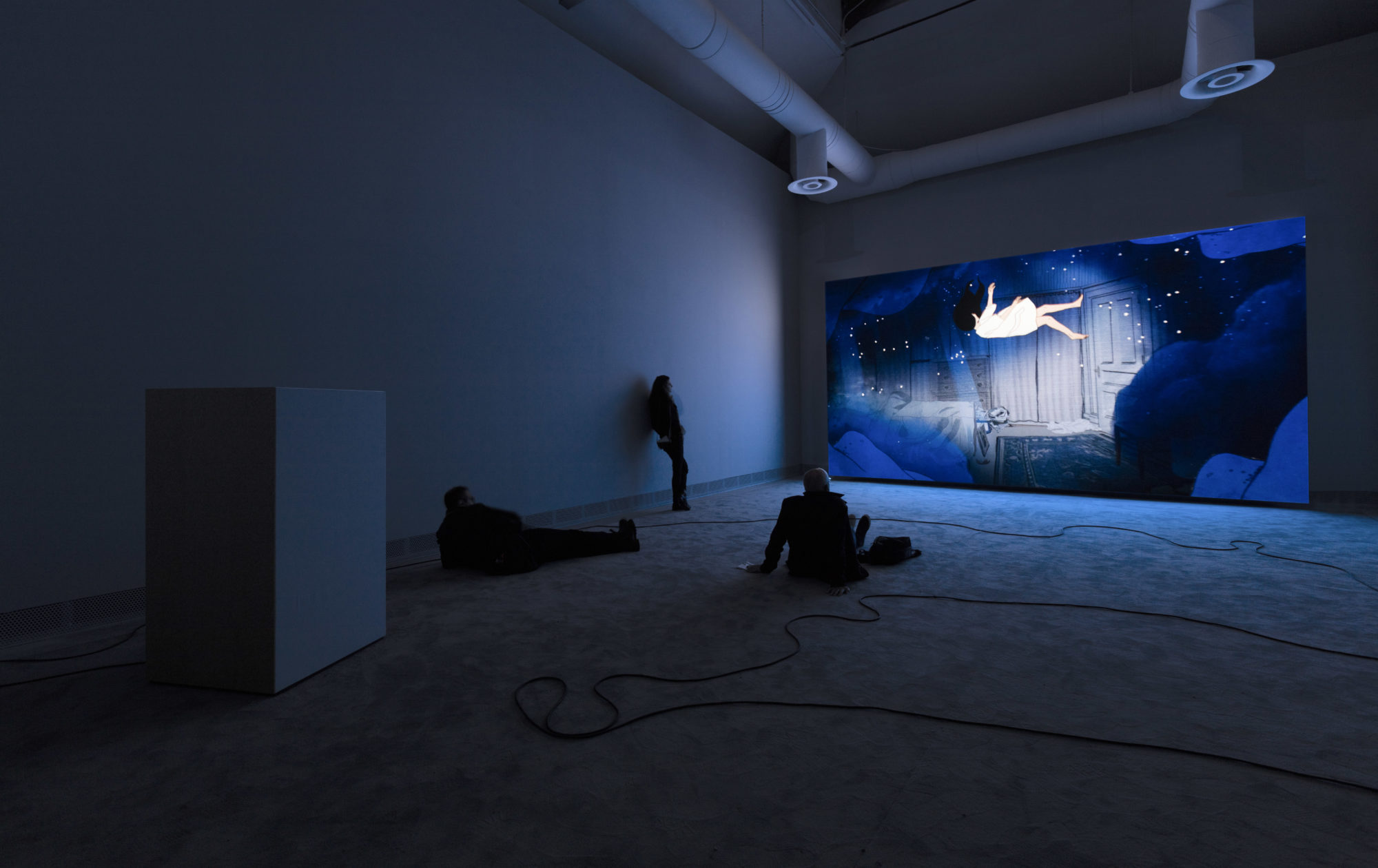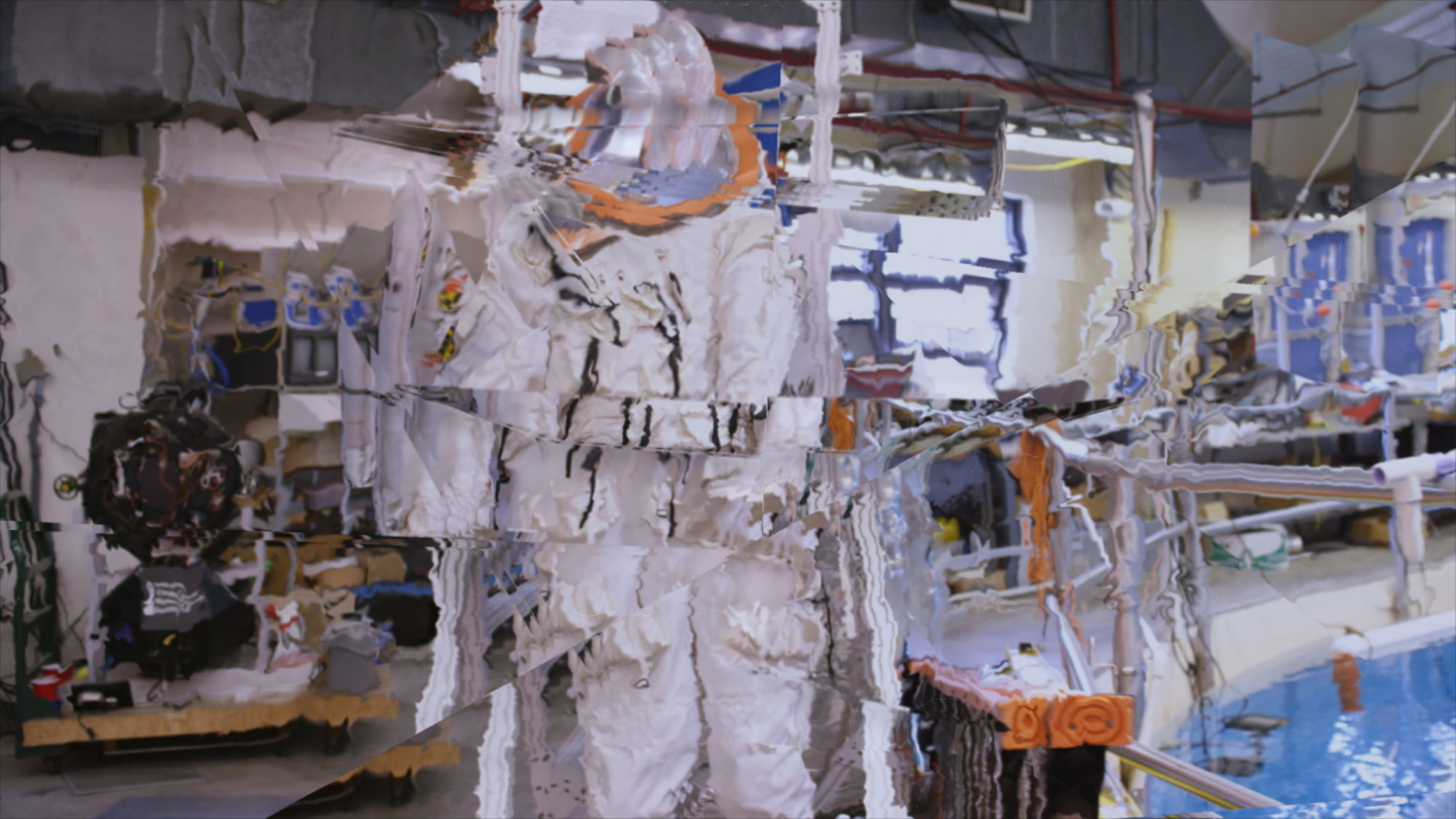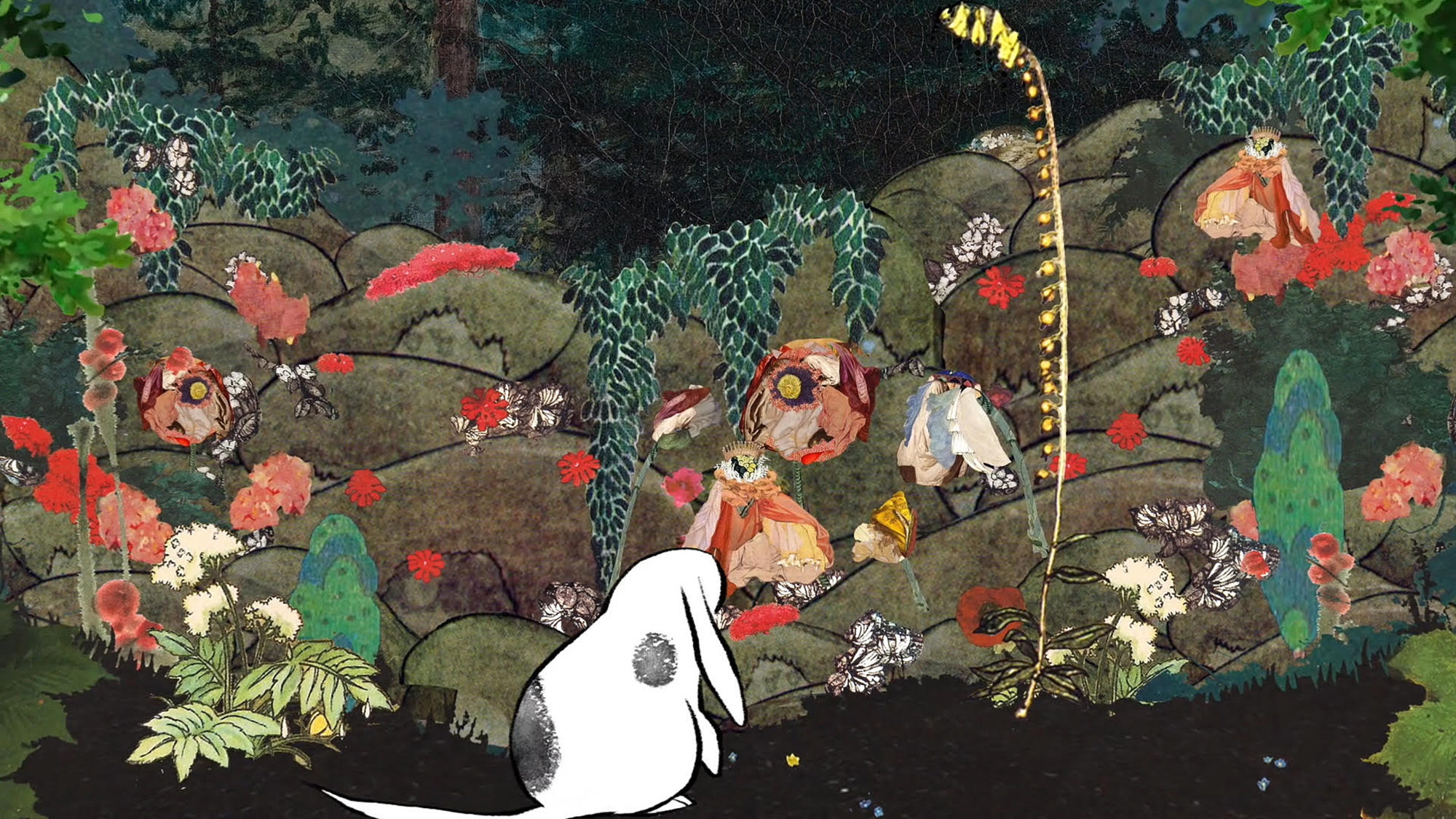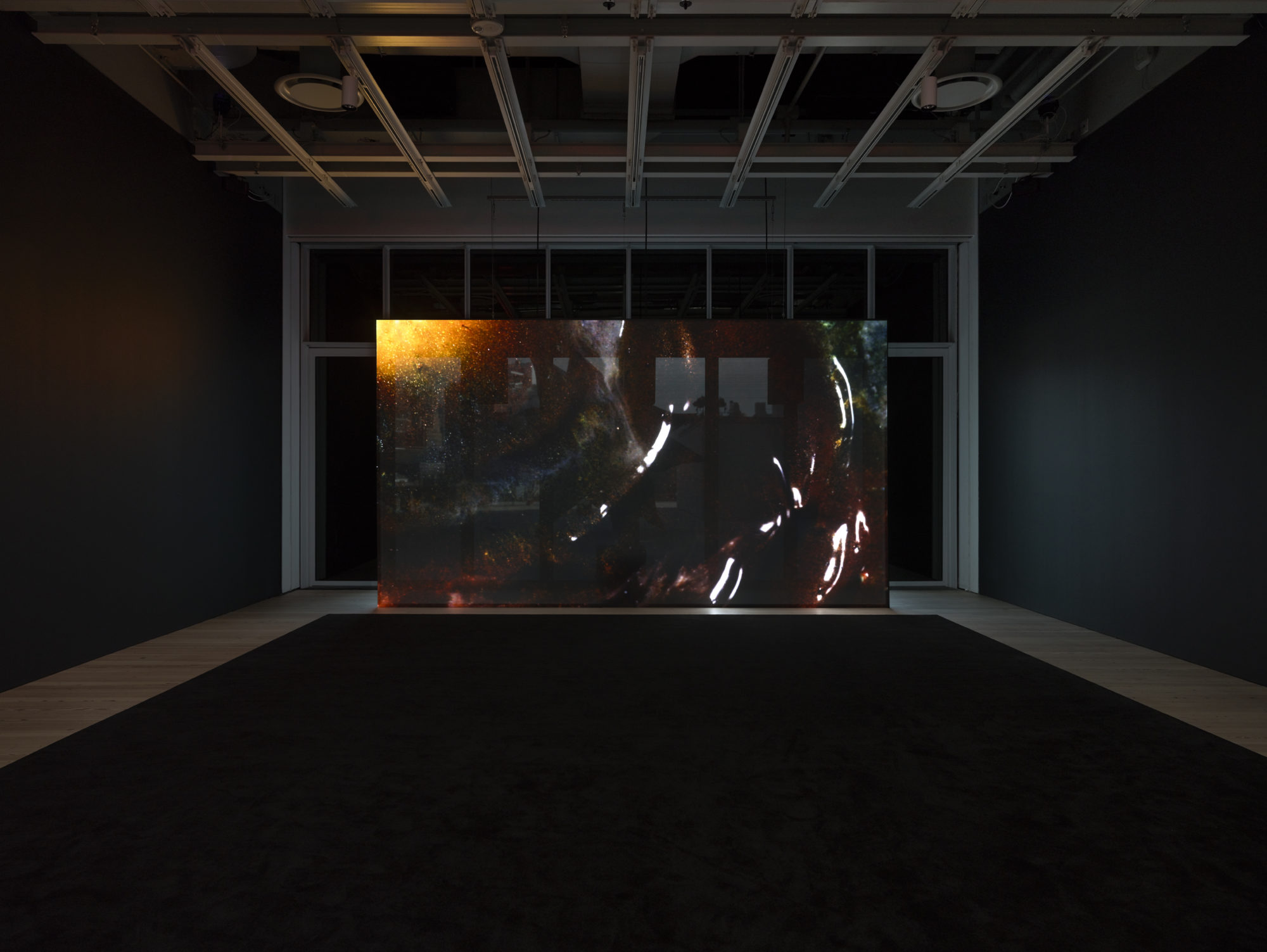
Installation view: Rachel Rose, Lake Valley, 2016, 57th Venice Biennale, Venice (May 13 – November 26, 2017). Courtesy of the artist, Gavin Brown’s enterprise, New York and Pilar Corrias Gallery, London. Photo: Andrea Rossetti.
Rachel Rose’s first video installation, Sitting Feeding Sleeping (2013), weaves together a dense narrative that explores nature and technology through images of animals, AI-controlled robots, and cryogenically frozen corpses. Rose’s investigation of embodiment in an age of technology began not as an art piece but as a documentary film. Rose began her practice as a painter while pursuing an MFA at Columbia University, but early on she became dissatisfied by the medium: “I couldn’t work within the limits of painting,” she says.1 So she began to experiment with video as a way to learn new skills and explore new ideas. Her research turned into an artwork, a stream-of-consciousness-like video that employs carefully edited still images and film fragments to convey sensory aspects of the themes of “deathfulness,” materiality, and corporeal mutation. In an almost dreamlike sequence in the video, a hushed voice says, “All you are is a means to mutate material.”

Rachel Rose. Still from Sitting Feeding Sleeping, 2013. HD video; 9 minutes and 49 seconds. Courtesy of the artist, Gavin Brown’s enterprise, New York and Pilar Corrias Gallery, London.
The project initiated a series of works in which process and content would play equally relevant roles in the development of the artist’s concept. “I set up every work almost as a container to hold a series of things that I want to know about; the work is an excuse to learn.” For example, Everything and More (2015), Rose’s commission for the Whitney Museum of American Art, began with her curiosity to learn about earlier forms of special effects. While Rose’s research for the work was centered on an interview with the astronaut David Wolf about his recollections of working in the Mir space station in the late 1990s, she conceived the video as a way to simulate at home the effects previously used only in Hollywood films. The work weaves together parts of Rose’s interview with Wolf and a performance by Aretha Franklin, edited using a spectrograph, an instrument that can split and analyze light or sound frequencies. “For me, using a spectrograph to edit frequencies was a completely new way of composing. The spectrograph is like a drawing; all the frequencies that you hear are, in a certain way, drawn.” The process of research and technical exploration is essential for Rose to conceive and develop a cohesive work of art. Viewers, in turn, attribute meaning to the work through watching it, without being aware of its process of creation. For Rose, what lies at the heart of each new project is the possibility to learn a new set of skills in order to attribute a specific meaning to each piece. “If I just wrote a straight narrative or applied an approach from an earlier work to the new one, the effort would fall flat because it would not be specific to what I’m trying to explore in this particular work.”

Rachel Rose. Still from Everything and More, 2015. HD video; 11 minutes and 39 seconds. Courtesy of the artist, Gavin Brown’s enterprise, New York and Pilar Corrias Gallery, London.
After addressing questions of embodiment and infinity in Everything and More, Rose immersed herself in the history of childhood for 2016’s Lake Valley. Intending to learn more about animation, Rose created an archive, compiling thousands of images from eighteenth- and nineteenth-century children’s book illustrations. She said, “I was interested in what qualifies as adulthood. At what point do you realize that you have a self? Where does this self-consciousness come from? In our culture, it is often in reference to a division between yourself now [as an adult] and yourself as a child.” Basing her research on Philippe Ariès’s book, Centuries of Childhood, Rose attempted to explore both the loneliness of childhood as well as the concept as a social construct. “I wanted to write a children’s story that culled themes that continued to come up in my research: abandonment, loneliness, independence. It seemed the transition from childhood to the adult self is often described through a narrative of loneliness. So I wrote a story about loneliness, and I made all the surfaces and textures that made up the narrative by putting together sections of images from these books and recomposing them.” Simultaneously, Rose gathered an extensive collection of sounds that she would then pair with specific scenes. “I wanted the sound to also connote this sense of displacement, of loneliness. Often in animation, the sound effects [known as Foley effects] that you hear don’t line up with the action. I worked with that difference: between what you hear and what you recognize as what you hear.” Once more, the intricate technical process behind the creation of a video provided the conceptual stepping-stone to materialize the research. “The pleasure of making a video, for me, is this constant textural, sensual work that it takes to orientate, to more fully ground, the subject I’m exploring, into something larger about living,” says Rose.

Rachel Rose. Still from Lake Valley, 2016. HD video; 8 minutes and 25 seconds. Courtesy of the artist, Gavin Brown’s enterprise, New York and Pilar Corrias Gallery, London.
For her next project, co-commissioned by the Philadelphia Art Museum and the Fondazione Sandretto Re Rebaudengo, which will debut in 2018, Rose has filmed in Plimouth, Massachusetts. She is attempting one of her most ambitious tasks yet: composing a complete piece of music to correspond to the narrative, the equivalent of a ten-minute song. “I feel like I have exhausted many of the techniques of sound design that I have been interested in learning, so now I am learning about music composition.” Written entirely in iambic pentameter—each line of verse has five pairs of syllables, each consisting of one unstressed syllable followed by a stressed one—the narrative takes place in seventeenth-century England, which has led Rose on a journey of researching poetry and music from that period. “It takes me so long to complete a work, because there’s much leg work before I can start digging into the edit, into putting it together.” After nine months of research and production, Rose affirms that she feels grounded enough in her material to be able to experiment with the technique. Just a few days ago, she heard a freeze transition in a piece of music and is now devoted to learning how to incorporate this kind of transition into her composition. She has reached a point where her process and concept meet: “Ultimately, I don’t know how to feel alive in the material that I’m thinking about, without also feeling alive with the way that I’m accessing that material.”

Installation view: Rachel Rose: Everything and More (October 30, 2015 – February 7, 2016), Whitney Museum of American Art, New York. Photography by Ron Amstutz.
1. Unless otherwise noted, all quotes by Rose are from a conversation with the author, June 29, 2017, New York City.



